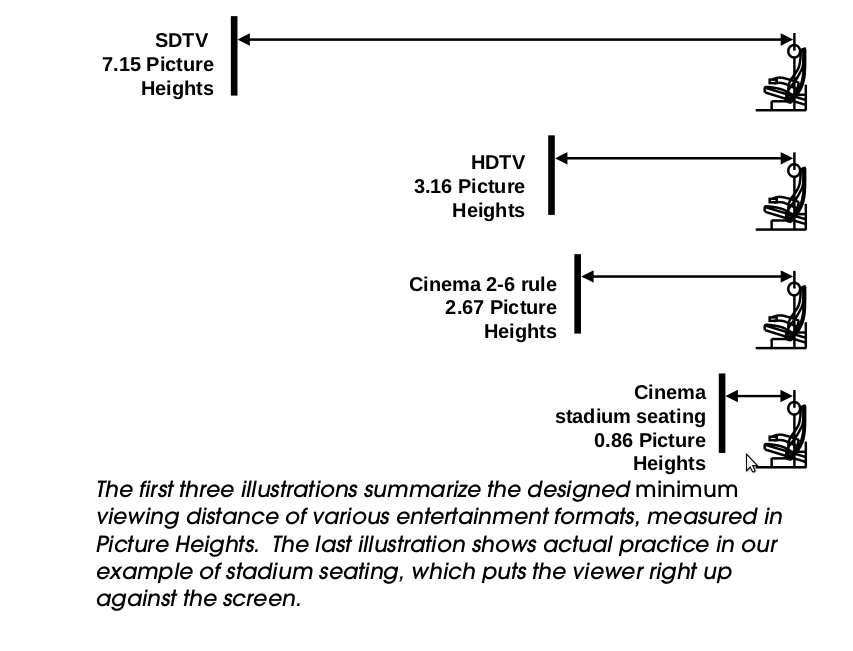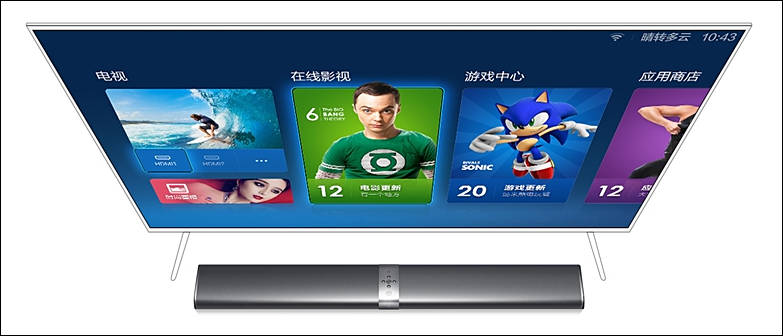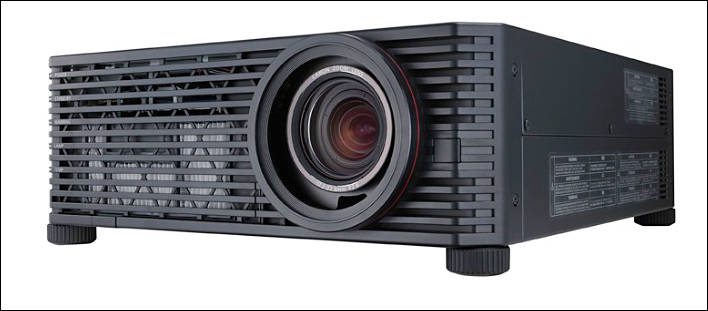
It allows to keep PV going, with more focus towards AI, but keeping be one of the few truly independent places.
-
When a local cinema replaced their film projectors with only 2K instead of 4K, I was disappointed. Sony explains why.
Picture Height: the measure of viewing distance

When the standard definition television system was first launched in North America, engineers assumed that viewers would want to sit at a sufficient distance for the individual scanning lines that comprise the picture to blend into a visually seamless whole. In the days before pixels, these engineers figured on 60 horizontal scanning lines per degree. From this, they derived a standard viewing distance of 7.15 Picture Heights (PH). Studies by Bernard Lechner of RCA in the US and Richard Jackson at Philips Laboratories in Europe determined that actual viewing distance for standard definition TV is around 10 feet (3 meters).8 The screen size that corresponds to 7.15 Picture Heights at this distance is 28 inches diagonal. This roughly matches the larger CRT sizes of the standard definition era.
Movie theater design has been influenced by similar calculations. In the 1940s, the Society of Motion-Picture Engineers (SMPE) made a recommendation called the 2-6 rule.9 It proposed that theater auditoriums be designed with the nearest seats at two times picture width and the farthest at six times picture width. Using the Academy Aperture screen shape of the time, that translates to a minimum viewing distance of 2.67 Picture Heights.
When high definition television was first proposed, the design goal was to equal the performance of movie theaters. This dictated an increase in TV resolution sufficient to create the illusion of a seamless image at roughly three Picture Heights.10 (The actual figure is 3.16 Picture Heights.) This similarity to the 2.67 specification of old movie theaters is not a coincidence. It is by design.
Since the 1940s, just about everything in movie theaters has been transformed, including auditorium design. Through the 1990s, new theater designs moved to progressively wider-angle projection lenses, which suggests that seats became progressively closer to the screen.11 By 1994, viewing distances that had once been considered the minimum were now close to the maximum. The renamed Society of Motion Picture and Television Engineers (SMPTE) issued Engineering Guideline EG 18- 1994, which recommended that the screen subtend a minimum horizontal angle of 30 degrees for viewers in the back of the room. This corresponds to a distance of 3.45 Picture Heights (using the5 contemporary picture proportions of 1.85:1). EG 18-1994 proved to be a snapshot of best practices at the end of the era of sloped-floor auditoriums.
It was withdrawn in 2003 as inappropriate for the new era of stadium seating auditoriums, which bring the audience even closer. In stadium seating, the back of the house is about three Picture Heights from the screen while the closest seats are less than one Picture Height away.
From Sony - Does 4K really make a difference? http://pro.sony.com/bbsccms/static/files/mkt/digitalcinema/Why_4K_WP_Final.pdf

 Cinema_Dimensions.png710 x 7 - 400B
Cinema_Dimensions.png710 x 7 - 400B
 Cinema_Screen_Distances.png853 x 651 - 67K
Cinema_Screen_Distances.png853 x 651 - 67K -
Intel and Warner Bros. are still very much embroiled in a war on companies stripping copyright protection from 4K and Blu-ray videos. Hardware seller Ace Deal has agreed to pay the two industry giants $5.2 million to settle a lawsuit over alleged violations of the Digital Millennium Copyright Act. Supposedly, Ace Deal knowingly aided in piracy by selling devices that remove HDCP anti-copying measures
It is time for another 100 companies to sell such stuff.
-
ULTRA HD PREMIUM
Enjoying a premium, full-featured Ultra High Definition in-home experience has been simplified for consumers as the UHD Alliance (UHDA), the inter-industry group charged with fostering the Ultra HD ecosystem and promoting the benefits of Ultra HD entertainment technology, today unveiled a consumer-facing logo to identify devices, content and services capable of delivering a premium experience to an exploding Ultra HD market that is expected to grow eightfold by 2019. The UHDA also announced the start of licensing of its ULTRA HD PREMIUM logo.
Developed through the collaborative efforts of leading film studios, consumer electronics manufacturers, content distributors and technology companies, the Ultra HD Premium specifications reflect collective expertise from across the Ultra HD ecosystem, as well as significant input gleaned from experiential consumer testing.
The UHDA’s ULTRA HD PREMIUM logo is reserved for products and services that comply with performance metrics for resolution, high dynamic range (HDR), peak luminance, black levels and wide color gamut among others. The specifications also make recommendations for immersive audio and other features. These advances in resolution, contrast, brightness, color and audio will enable certified displays and content to replicate the richness of life’s sights and sounds and allow in-home viewers to more fully and accurately experience the content creator’s vision.
“The diverse group of UHDA companies agreed that to realize the full potential of Ultra HD the specs need to go beyond resolution and address enhancements like HDR, expanded color and ultimately even immersive audio. Consumer testing confirmed this,” said UHD Alliance President Hanno Basse. “The criteria established by this broad cross section of the Ultra HD ecosystem enables the delivery of a revolutionary in-home experience, and the ULTRA HD PREMIUM logo gives consumers a single, identifying mark to seek out so they can purchase with confidence.”
To ensure products bearing the ULTRA HD PREMIUM logo are certified and conform to the organization’s specifications, the UHDA has designated multiple, independent centers around the globe to handle testing. Companies throughout the ecosystem will work directly with these centers to have their products tested and certified.
The UHDA’s new ULTRA HD PREMIUM specifications cover multiple display technologies and reference established industry standards and recommended practices from the Consumer Technology Association, the Society of Motion Picture and Television Engineers, the International Telecommunications Union and others.
“Ever-rising consumer adoption of Ultra HD TV sets will fuel strong growth for the entire Ultra HD ecosystem over the next few years,” noted Paul Erickson, senior analyst at IHS Technology. “Annual worldwide shipments of Ultra HD TVs are expected to grow nearly 719% over the next several years according to IHS’ forecasts, from nearly 12 million in 2014 to nearly 96 million in 2019, with over 300 million in use by the end of 2019. For the many mainstream consumers looking to make sense of the various terminologies, acronyms and feature descriptions at retail, standardization efforts such as the UHDA’s “ULTRA HD PREMIUM” can reduce consumer confusion and help ensure consistency of both buyer expectations and the delivery of the end experience - benefiting not only consumers, but also the industry as a whole.”
Founded in January, 2015, the UHDA, has grown to more than 35 companies in two membership categories - Board and Contributor. In 2016, the UHDA will add a third member category, Adopter, for those who wish to license the Ultra HD Premium specifications. Collectively, the UHDA member companies will continue to lead the charge into this new era of home entertainment through advances in resolution, brightness, contrast, dynamic range, color and audio.
-

70" Xiaomi 4K TV with brains in external module, coming at CES for around $1540

 zebra600.jpg783 x 336 - 42K
zebra600.jpg783 x 336 - 42K -
TV reviewers -- folks like me who try to help you decide what's actually worth buying -- look at HDR as a potentially more important improvement than 3D or 4K. Its benefits can be more visible than 4K and more broadly appealing than 3D.
And guys like me think that promoting HDR on 99% of current TVs is close to criminal behavior (contrary to 3D and 4K).
-
Just a few years behind YouTube. A welcome upgrade, nonetheless.
-
Vimeo is getting ready to go 4K: The IAC-owned video platform started to roll out adaptive bitrate streaming across its service Thursday, which will allow it to stream videos with a resolution of up to 4K video to its viewers. “We launched 4K upload support for PRO members last year, and now, as we start to see more widespread adoption of 4K-enabled screens in the market, we’re excited to roll out adaptive streaming across Vimeo,” said Vimeo CEO Andrew Pile.
-

Canon U.S.A., Inc., a leader in digital imaging solutions, today unveiled its REALiS 4K500ST Pro AV LCOS Projector which delivers 4K resolution of 4096 x 2400, up to 5000 lumens* and Canon’s LCOS Technology with AISYS-enhancement for brilliant, high-brightness and detailed image reproduction. The REALiS 4K500ST also offers a Genuine Canon 4K lens and a robust collection of advanced professional setting features, including Marginal Focus which helps ensure content projected on the peripheral portions of domed surfaces remains in focus.
At only 38.8 pounds this model also offers one of the most compact and lightweight form factors of a high brightness 4K Projector. The REALiS 4K500ST’s combination of outstanding image quality, advanced features and compact size make it ideal for applications like immersive simulation and training which require outstanding image quality but may have limited spacing.
“Demand for 4K projection display continues to rapidly expand in many existing and new markets, and Canon has responded by developing a unique model that combines 4K resolution and high brightness in a compact form factor,” said Yuichi Ishizuka, president and chief operating officer, Canon U.S.A., Inc. “Canon has leveraged its decades of expertise in advanced optics, image processing, and projection technologies to help the REALiS 4K500ST LCOS Projector deliver outstanding 4K image quality, versatile display features, and compact size needed to satisfy many of the requirements of today’s 4K projection professionals.”

 zebra458.jpg708 x 311 - 34K
zebra458.jpg708 x 311 - 34K -
Anyone besides me find it unusual that the video on how to make a video has no video?
-
Samsung Display has reportedly succeeded in developing a new type of RGBW Ultra HD (4K) TV panel technology it refers to as Green 2 that will go into mass production in 2016, according to a report from Korea-based Digital Daily.
The technology will be used in new high-end TVs sized 55- and 65-inch set to be released in 2016, the report said. Samsung however will continue to use its Green 1 technology on smaller-size 4K TVs such as 40- and 48-inch units since costs are cheaper due to a simplified production process that leaves out photoresist for whites used in the RGBW structure.
Consequence of non existing HDR :-) Will also affect usage of them as monitors.
-
Samsung Electronics Co., Ltd., announced today that its 2015 SUHD and UHD TVs will be the first on the market capable of supporting the new HDMI 2.0a specification. Samsung will issue a firmware update that will enable its 2015 SUHD and UHD TVs to display a broader library of High Dynamic Range (HDR) content now from external devices. HDR delivers a much higher level of contrast between light and dark to produce an image that is more realistic and closer to what the content creator imagined. The firmware update is available now at no additional cost to owners of 2015 Samsung SUHD and UHD TV’s.
Continue of scam. On LCD it can means only making backlight extreme and adding some "good looking" filters killing near blacks.
-
Another scam continues:
A TV, monitor or projector may be referred to as a HDR Compatible Display if it meets the following minimum attributes:
- Includes at least one interface that supports HDR signaling as defined in CEA-861-F, as extended by CEA-861.3.
- Receives and processes static HDR metadata compliant with CEA-861.3 for uncompressed video.
- Receives and processes HDR10 Media Profile* from IP, HDMI or other video delivery sources. Additionally, other media profiles may be supported.
- Applies an appropriate Electro-Optical Transfer Function (EOTF), before rendering the image.
“CEA’s leading role in defining HDR compatible displays complements the work of other organizations such as the UHD Alliance that are reportedly developing HDR-related performance parameters and guidance for the video content, distribution and hardware ecosystem,” Markwalter explained.
In other world - any TV can be made HDR with just HDMI interface changes and some firmware updates :-)
-
I wasn't condemning anyone for buying new stuff. I just see a lot of signs that people tend to be pretty satisfied with their existing gear and the new features don't drive new purchases as they used to. Just looking at your figures, it appears that even though Samsung is gaining market share, its actual production is decreasing. If these are true then others like LG must really be scaling back.
-
People who are buying these things now are either the wealthy, tech fanboys, people who've sat out several rounds of new features, or new consumers like children/teens reaching the age where they need their own gear.
Sometimes it is just good people who want to try something new :-)
-
Korea vendors' shipment share rose to 61% from 54%, with shipment volume growing 80% sequentially. Samsung Display enjoyed the highest sequential growth at 105% with 3.3 million shipment volume, enlarging its gap with LG Display and becoming the world's number one panel vendor for 4K LCD TVs. The majority of Samsung's shipped panels were 55- and 48-inch, together accounting for 70% of its total shipments, followed by 40-inch panels at 20%.
-
There are a lot of consumer goods these days that have reached the "good enough" point for most consumers where new features don't drive a need to purchase. TVs are there, cameras, computers, tablets, cell phones. Tablets reached this point almost on launch -- certainly by the iPad2. It's not that the new features aren't interesting, but they don't create enough of an improvement to be worth the money, even at the rapidly falling cost of technology.
People who are buying these things now are either the wealthy, tech fanboys, people who've sat out several rounds of new features, or new consumers like children/teens reaching the age where they need their own gear.
-
Serious issues on TV market
Samsung Electronics reduced TV production capacity globally by 10 million units in the first half of 2015 and is expected to decrease by another 10 million units in the second half of the year for a total of 42 million units, down from 62.99 million in 2014.
LG Electronics' TV production capacity meanwhile dropped 5.6% on year in the first half of 2015 to 17.49 million, with only 12.09 million TVs actually produced to represent a 19% on-year decline.
-
According to Futuresource Consulting, Ultra HD (4K) TV shipments are expected to grow by 147% in 2015, despite overall 2% fall in TV sales
-
Some high end specs on a thin 4K TV: http://www.slashgear.com/xiaomis-smart-mi-tv-2s-is-almost-ridiculously-thin-16393331/
-
4K TVs in the Japan market have reached a 30% share of overall LCD TV sales during certain months, and the 50-inch and above size proportion has climbed from 40% in previous months.
Nod bad.
Howdy, Stranger!
It looks like you're new here. If you want to get involved, click one of these buttons!
Categories
- Topics List23,911
- Blog5,718
- General and News1,330
- Hacks and Patches1,148
- ↳ Top Settings33
- ↳ Beginners254
- ↳ Archives402
- ↳ Hacks News and Development56
- Cameras2,342
- ↳ Panasonic984
- ↳ Canon118
- ↳ Sony154
- ↳ Nikon95
- ↳ Pentax and Samsung70
- ↳ Olympus and Fujifilm98
- ↳ Compacts and Camcorders295
- ↳ Smartphones for video96
- ↳ Pro Video Cameras191
- ↳ BlackMagic and other raw cameras116
- Skill1,959
- ↳ Business and distribution66
- ↳ Preparation, scripts and legal38
- ↳ Art149
- ↳ Import, Convert, Exporting291
- ↳ Editors190
- ↳ Effects and stunts115
- ↳ Color grading197
- ↳ Sound and Music280
- ↳ Lighting96
- ↳ Software and storage tips266
- Gear5,407
- ↳ Filters, Adapters, Matte boxes344
- ↳ Lenses1,577
- ↳ Follow focus and gears93
- ↳ Sound496
- ↳ Lighting gear313
- ↳ Camera movement230
- ↳ Gimbals and copters302
- ↳ Rigs and related stuff271
- ↳ Power solutions83
- ↳ Monitors and viewfinders339
- ↳ Tripods and fluid heads139
- ↳ Storage286
- ↳ Computers and studio gear559
- ↳ VR and 3D248
- Showcase1,859
- Marketplace2,834
- Offtopic1,314







